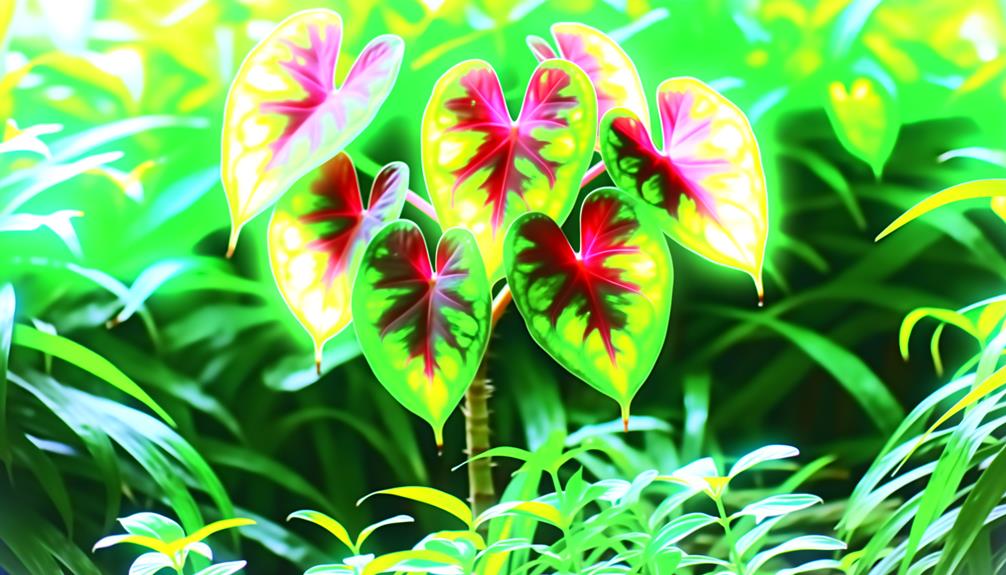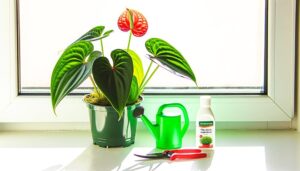What Makes the Ace of Hearts Plant Special?
The Ace of Hearts plant stands out because of its bilateral symmetrical, heart-shaped leaves with vibrant deep green and striking red pigments. It's remarkably low maintenance, thriving indoors and purifying air effectively.
You won't have trouble with pests, and it's pet-friendly as well. For best growth, it likes consistently moist soil and bright, indirect light while avoiding direct sunlight.
This plant's compact growth habit and ease of propagation make it an excellent choice for any indoor setting. Discover more about its specific lighting and watering needs to achieve peak health and beauty.

Key Takeaways
- The Ace of Hearts plant features heart-shaped leaves with unique bilateral symmetry, maximizing sunlight capture and photosynthesis.
- Its deep green and striking red coloration protects against UV light and attracts beneficial insects for pollination.
- The plant is non-toxic and pet-friendly, making it a safe choice for households with pets.
- It effectively purifies indoor air by removing pollutants like formaldehyde and benzene, promoting respiratory health.
- Low maintenance with drought tolerance, it thrives in various soil and lighting conditions, requiring minimal care.
Unique Leaf Shape
The Ace of Hearts plant stands out due to its leaves, which are uniquely heart-shaped and exhibit a symmetry that's both scientifically intriguing and aesthetically pleasing.
You'll notice that the bilateral symmetry of each leaf ensures both sides mirror each other perfectly. This precise symmetry is a result of genetic regulation during the plant's growth, guaranteeing uniform cell division and expansion.
The heart shape itself is an adaptation that maximizes sunlight capture, increasing photosynthetic efficiency. When you observe the leaves closely, you can see the veins branching out methodically, optimizing nutrient and water transport.
The apex of the leaf, the pointed end, aids in water runoff, preventing fungal growth. This combination of form and function makes the Ace of Hearts plant truly remarkable.
Vibrant Coloration
In addition to its unique leaf shape, you'll find the Ace of Hearts plant exhibits vibrant coloration, with hues of deep green and striking red that serve both aesthetic and functional purposes.
The deep green chlorophyll maximizes photosynthesis efficiency, ensuring the plant's growth and importance. The striking red pigmentation, primarily due to anthocyanins, offers protection against ultraviolet light and deters herbivores, reducing leaf damage.
This coloration also aids in attracting beneficial insects, facilitating pollination. Furthermore, the contrast between green and red creates a visually stunning appearance, making the Ace of Hearts a popular choice for ornamental purposes.
Low Maintenance
Beyond its vibrant coloration, the Ace of Hearts plant stands out for its low maintenance requirements, making it an ideal choice for both novice and experienced gardeners. You'll find that it thrives in a variety of soil conditions, requiring minimal fertilization. Its drought tolerance means you won't need to water frequently, reducing the risk of root rot. This plant also exhibits strong pest resistance, minimizing the need for chemical treatments.
Additionally, it adapts well to different lighting conditions, from partial shade to indirect sunlight. Pruning is rarely necessary, allowing it to maintain its shape naturally. Overall, the Ace of Hearts plant offers a blend of resilience and ease, ensuring that your gardening experience remains both enjoyable and stress-free.
Ideal Indoor Plant
You'll appreciate the Ace of Hearts plant for its low maintenance needs, making it perfect for busy lifestyles.
It also enhances indoor air quality by efficiently removing toxins.
Combining ease of care with air purifying qualities, this plant is a stellar choice for any indoor space.
Low Maintenance Needs
The Ace of Hearts plant thrives with minimal care, making it an ideal choice for indoor gardeners seeking a low-maintenance yet visually appealing addition to their home.
You'll appreciate its resilience and adaptability to various indoor conditions. This plant demands little from you, yet offers much in return.
- Watering: Requires watering only when the top inch of soil is dry, preventing overwatering issues.
- Light: Tolerates low to medium light, perfect for spaces without direct sunlight.
- Soil: Prefers well-draining potting mix, reducing the risk of root rot.
This easy-care routine is grounded in the plant's natural efficiency in resource use. By understanding these basic needs, you'll find maintaining the Ace of Hearts plant both rewarding and straightforward.
Air Purifying Qualities
Studies have shown that the Ace of Hearts plant effectively removes common indoor pollutants, making it an excellent choice for improving air quality in your home.
This plant targets volatile organic compounds (VOCs) like formaldehyde, benzene, and trichloroethylene, which are often emitted from household items such as paint, furniture, and cleaning products.
The plant's large surface area and efficient transpiration rate allow it to absorb these toxins through its leaves and roots.
By incorporating the Ace of Hearts into your indoor space, you're not just adding greenery but also promoting a healthier environment.
With its superior air-purifying qualities, this plant supports respiratory health and overall well-being, making it an ideal addition to any living space.
Air Purification
You'll find that the Ace of Hearts plant excels at removing indoor toxins like formaldehyde and benzene.
By enhancing oxygen levels, it creates a healthier environment in your home.
Additionally, it actively reduces airborne allergens, making it an excellent choice for improving indoor air quality.
Removes Indoor Toxins
An Ace of Hearts plant not only enhances your home's aesthetics but also actively purifies the air by removing harmful indoor toxins like formaldehyde and benzene. These volatile organic compounds (VOCs) can emanate from common household items such as furniture and cleaning products, posing health risks over time.
The plant's leaves absorb these toxins and break them down at a cellular level.
Formaldehyde, found in items like plywood and synthetic fabrics, is linked to respiratory issues and even cancer.
Benzene, present in paints and detergents, is known to cause dizziness and long-term health problems.
Trichloroethylene, often emitted from adhesives and paint removers, can lead to headaches and liver dysfunction.
Enhances Oxygen Levels
The Ace of Hearts plant greatly enhances indoor oxygen levels by undergoing photosynthesis, a process where it converts carbon dioxide into oxygen. During daylight, its chlorophyll captures sunlight, triggering a chemical reaction that splits water molecules and releases oxygen.
This oxygen output not only freshens the air but also improves your overall indoor air quality. You'll find that this enhanced oxygen level can lead to better respiratory health, increased focus, and overall well-being.
The plant's broad leaves maximize its photosynthetic efficiency, making it a superb choice for oxygenating spaces.
Reduces Airborne Allergens
In addition to boosting oxygen levels, the Ace of Hearts plant actively purifies indoor air by reducing airborne allergens, thanks to its remarkable ability to trap and neutralize pollutants on its broad, waxy leaves.
This plant filters out common irritants such as dust, pollen, and mold spores, making your living space healthier. It's not just about removing visible particles; the Ace of Hearts also addresses invisible volatile organic compounds (VOCs) that can negatively impact your health.
- Dust Particles: Captures and holds dust, reducing respiratory irritations.
- Pollen: Minimizes allergic reactions by filtering out pollen grains.
- Mold Spores: Limits mold spore presence, decreasing the risk of mold-related health issues.
Pet-Friendly Choice
When choosing houseplants, you'll find the Ace of Hearts plant stands out as a safe, pet-friendly option due to its non-toxic properties.
Unlike many common houseplants that contain harmful chemicals, the Ace of Hearts doesn't pose a threat to your furry friends. Scientifically, this plant's tissues lack the toxic compounds like oxalates and saponins found in others, making it harmless if ingested by pets.
Additionally, its attractive heart-shaped leaves and ease of care make it an ideal choice for any home. You can rest assured knowing your pets won't suffer from accidental nibbling.
This plant's safety profile doesn't compromise its beauty, allowing you to enjoy a vibrant, green space without worrying about your pet's health.
Easy Propagation
Propagating the Ace of Hearts plant is straightforward and highly effective, allowing you to expand your collection with minimal effort.
To begin, you'll need to take a healthy stem cutting, preferably with at least two leaves. Place the cutting in water or moist soil to encourage root development. Keep the medium consistently moist but not waterlogged to prevent rot.
Key factors to take into account include:
- Humidity: Sustain a high humidity level to facilitate root growth.
- Light: Provide indirect sunlight, as direct exposure can harm the delicate cutting.
- Temperature: Keep the environment warm, ideally between 65-75°F (18-24°C), to promote ideal growth.
Growth Habits
The Ace of Hearts plant typically exhibits a compact growth habit, characterized by its heart-shaped leaves and dense foliage. You'll notice that its stems stay relatively short, producing a bushy appearance that's perfect for small spaces.
It's a slow to moderate grower, which means you won't have to worry about constant pruning. The leaves are arranged in an alternating pattern, maximizing light capture and minimizing self-shading. This plant's root system is fibrous, allowing it to efficiently absorb nutrients and water.
You'll find that it thrives in well-draining soil, maintaining its compact form without becoming leggy. Its growth habit makes it an excellent choice for container gardening or table displays, ensuring year-round visual appeal.
Suitable Lighting
To optimize the growth of your Ace of Hearts plant, you'll need to provide it with bright, indirect light. Direct sunlight can cause leaf burn, so place it near a window with filtered light.
Consistent exposure to these ideal conditions guarantees robust foliage and vibrant color.
Ideal Light Conditions
For best growth, make certain your Ace of Hearts plant receives bright, indirect light for most of the day. This type of lighting provides the prime energy for photosynthesis without the risk of leaf damage. Aim for a consistent light source to secure even growth and vibrant foliage.
- Artificial Lighting: Use fluorescent or LED grow lights if natural light is insufficient.
- Light Duration: Make certain your plant receives 12-14 hours of light daily to mimic its natural environment.
- Light Intensity: Maintain a light intensity of 1,000-2,000 foot-candles to foster prime growth.
Avoiding Direct Sunlight
Direct sunlight can scorch the leaves of an Ace of Hearts plant, leading to unsightly burn marks and stunted growth. You should place your plant in an area where it receives bright, indirect light for best health. Use sheer curtains or position it near an east-facing window to filter the light. Understanding light requirements is key to maintaining its vibrant foliage.
Here's a quick reference table:
| Light Condition | Impact on Ace of Hearts Plant |
|---|---|
| Direct Sunlight | Leaf scorch, burn marks, stunted growth |
| Bright Indirect Light | Ideal growth, vibrant foliage |
| Low Light | Slower growth, pale leaves |
| Filtered Light | Healthy, steady development |
| Artificial Light | Can supplement natural light |
Watering Needs
Understanding the watering needs of the Ace of Hearts plant is essential, as it thrives in consistently moist but not waterlogged soil. You'll want to water it regularly, making sure the soil remains damp but not soggy.
Overwatering can lead to root rot, while underwatering can cause the leaves to wilt and lose their vibrant color.
Key points to keep in mind:
- Soil Moisture: Check the top inch of soil; it should be moist to the touch.
- Water Frequency: Water approximately once a week, but adjust based on humidity and temperature.
- Drainage: Ensure the pot has drainage holes to prevent water accumulation at the roots.
Conclusion
To sum up, you'll find the Ace of Hearts plant a delightful companion for your indoor sanctuary. Its heart-shaped leaves and vibrant colors brighten any room, while its low maintenance and easy propagation make it a breeze to care for.
This plant not only enhances your living space but also purifies the air, ensuring a healthier environment. With its adaptable growth habits and minimal watering needs, it's an ideal choice for both novice and seasoned plant enthusiasts.






